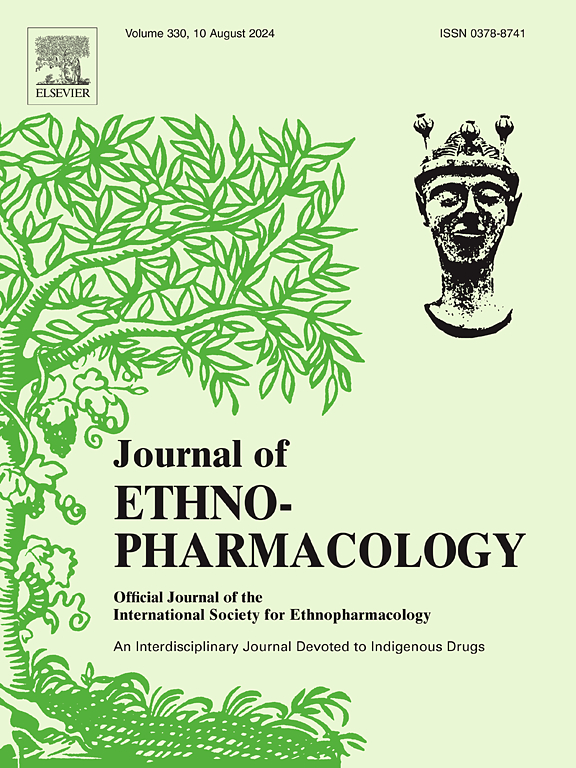Study on the compatibility of japonica rice in Xie-Bai-San decoction based on characterization, multi components quantification, and pharmacokinetics
IF 4.8
2区 医学
Q1 CHEMISTRY, MEDICINAL
引用次数: 0
Abstract
Ethnopharmacological relevance
Xie-Bai-San decoction (XBS), which is effective in treating coughs associated with lung heat, is composed of four Chinese medicines: Morus alba L. (known as Sangbaipi), Lycii Cortex (known as Digupi), licorice (Glycyrrhiza uralensis Fisch.), and japonica rice. The original prescription of XBS and its modified prescriptions have been greatly expanded in clinical application. However, japonica rice as a guiding drug is often ignored, which effects on composition and metabolism in vivo have not been fully studied.
Aim of the study
The purpose of this study was to explain the compatibility of japonica rice in the XBS. By comparing the physical state of the XBS without japonica rice decoction (XBS-JM) and measuring the content of 26 indicative components in both XBS and XBS-JM decoctions, this study illustrated how japonica rice affected the overall physical state and the dissolution of components during the decoction process.
Combined with the analysis of the pharmacokinetic characteristics of 18 active components absorbed into the blood, the effect of japonica rice and the scientific basis of prescription compatibility were comprehensively discussed.
Methods
A sensitive and reliable UPLC-Q-TOF-MS qualitative analysis method was developed to analyze the chemical constituents of XBS. Taking the change of the remaining volume of the decoction as the index, the decoction time of 30, 50 and 90 min was selected. A Malvern particle size apparatus and transmission electron microscopy (TEM) were utilized to investigate the influence of japonica rice on phase states. Additionally, a highly selective and sensitive UPLC-MS/MS quantitative analysis method was established to detect changes in the content of 26 chemical components in the decoctions at three different decoction time. The pharmacokinetic parameters of 18 components were also studied following the oral administration of XBS and XBS-JM in both control and model animals.
Results
The results showed that the particle size of the XBS and XBS-JM decoction, following dialysis-ultracentrifugation, was predominantly in the nano-scale range. The addition of japonica rice (JM) enhanced the stability of the nanoparticles, and the concentrations of guanosine, chlorogenic acid, kukoaMine B, astragalin, and naringenin in the XBS decoction were significantly higher than those in the XBS without japonica rice (XBS-JM) decoction. The results of pharmacokinetics showed that compared with the administration of XBS-JM, XBS significantly enhanced the absorption of eight components in the control group, such as kukoaMine B, kuwanon G, wogonoside, and liquiritin. In the model group, following the administration of XBS, the absorption rates of six components, such as kukoaMine B, kuwanon G, and 18β-glycyrrhetinic acid were significantly increased (p < 0.05), with the peak concentration of 60 % of the components also showing a notable rise.
Conclusion
This study provides experimental evidence regarding physical characterization, multi components quantification, and pharmacokinetics, which might help to explain the rationality of the compatibility of japonica rice in the prescription, and the influence on the effective substance basis of traditional Chinese medicine (TCM).

求助全文
约1分钟内获得全文
求助全文
来源期刊

Journal of ethnopharmacology
医学-全科医学与补充医学
CiteScore
10.30
自引率
5.60%
发文量
967
审稿时长
77 days
期刊介绍:
The Journal of Ethnopharmacology is dedicated to the exchange of information and understandings about people''s use of plants, fungi, animals, microorganisms and minerals and their biological and pharmacological effects based on the principles established through international conventions. Early people confronted with illness and disease, discovered a wealth of useful therapeutic agents in the plant and animal kingdoms. The empirical knowledge of these medicinal substances and their toxic potential was passed on by oral tradition and sometimes recorded in herbals and other texts on materia medica. Many valuable drugs of today (e.g., atropine, ephedrine, tubocurarine, digoxin, reserpine) came into use through the study of indigenous remedies. Chemists continue to use plant-derived drugs (e.g., morphine, taxol, physostigmine, quinidine, emetine) as prototypes in their attempts to develop more effective and less toxic medicinals.
 求助内容:
求助内容: 应助结果提醒方式:
应助结果提醒方式:


